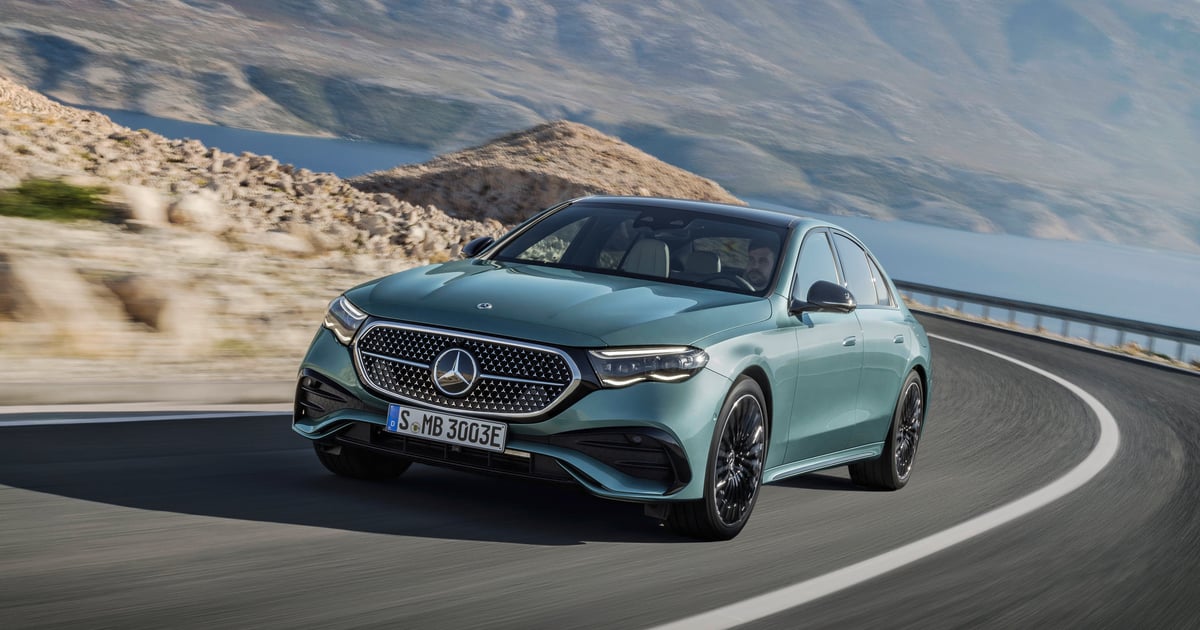
Mercedes-Benz’s workhorse E-Class sedan, redesigned for 2024, teases the German luxury automaker’s bespoke and in-house-developed operating system.
The midsize sedan arrives in the U.S. in late 2023 with new styling and the latest version of the MBUX infotainment system. Pricing was not disclosed.
Mercedes will ditch the coupe and convertible body styles with the new generation. AMG variants could arrive in the future.
The E-Class is a pivotal piece of Mercedes’ global business. With more than 16 million delivered since 1946, it is the brand’s bestselling model series, according to Mercedes.
Despite being in the final year of its product life cycle, the E-Class, along with the CLS, was Mercedes’ second-bestselling sedan in the U.S. last year. Mercedes combines the two vehicles in its sales reports. The nameplates accounted for 18,818 sales.
The new-gen E-Class is in production in Sindelfingen, Germany. Output should peak at more than 140,000 in 2024, according to S&P Global Mobility.
The 11th-generation E-Class is built on a modified version of the platform that underpins the C-Class compact sedan and GLC compact crossover.
The E 350 variant receives a new 2.0-liter, four-cylinder engine that produces 255 hp.
Like the 375-hp E 450, the base model gets electrified with a 48-volt mild-hybrid system and a starter generator integrated into the transmission. The electrified powertrain boosts performance and fuel economy. The system adds 20 hp more.
In the U.S., Mercedes will not offer a plug-in hybrid variant of the E-Class. “Market research shows that North American customers either go all the way toward a full-electric-driven car or a combustion engine car,” Dirk Fetzer, Mercedes director of product management, said during a media roundtable Monday.
Optional rear-axle steering improves the E-Class’ agility and stability. The steering angle at the rear axle is 4.5 degrees, which reduces the turning radius by up to 35.4 inches. The 4Matic variant’s turning radius is 36.5 feet.
The E-Class features a short front overhang, a spacious hood, and styling inspired by the brand’s EQ electric lineup.
A black panel in high-gloss black connects the grille with the headlights, a similar look to Mercedes electric models. The grille is blinged up with an optional illuminated surround.
In addition to high-performance LED headlamps, an optional Digital Light system can project symbols onto the roadway to warn and support the driver in particularly challenging situations.
Flush door handles give the sedan a more aero appearance similar to the upmarket S-Class.
The rear of the vehicle sports taillights with a unique design: a star motif with a day and night design.
An extended wheelbase (0.87 inch longer) delivers a roomier interior than the outgoing model.
Rear passengers have an additional 0.6 inch of legroom. Up front, the driver gets 0.2 inch more headroom.
The redesigned E-Class features technology that transforms the vehicle into a mobile work and entertainment space.
A high-resolution display anchors the cockpit. When combined with the optional front passenger screen, the display extends from the instrument cluster unit to the A-pillar on the passenger side. Models without the passenger display feature a trim element that extends to the center.
A narrow climate control vent sits against the upper contour of the display’s glass surface, connecting the central duct with the outer climate control vents to form a single unit.
A light strip illuminates the instrument panel’s front section. The lighting element, which runs in an arc from the windshield, past the A-pillars and into the doors, visually interprets the audio playing in the car.
Software analyzes the audio signals based on frequency and direction. Fast sequences of beats, for instance, lead to rapid light changes, while “flowing rhythms create softly merging lighting moods,” Mercedes said.
The latest version of the MBUX infotainment system delivers greater personalization by learning the driver’s frequently used comfort settings and enabling programmable routines, Mercedes said.
In a nod to younger buyers, notably those in China, MBUX integrates with the Android operating system and allows the installation of third-party apps such as TikTok, Zoom and Webex. The E-Class’ optional onboard selfie and video camera can also be used for conference calls.
A central computer powers the screens and the MBUX system, enabling faster data transfers and snappier performance, MBUX boss Michael Hafner told Automotive News in February.
Hafner said that unified computer architecture saves hardware costs and makes software development more efficient.
Mercedes also uses software, cameras and seat sensors to reduce driver distraction in the E-Class.
The passenger display’s “dual light control” technology, developed by Mercedes, can prevent content such as videos from being seen peripherally by the driver while the vehicle is in motion.
An in-cabin camera detects if the driver is looking at the front passenger screen instead of the road. The technology dims the brightness of the passenger screen so it’s not visible to the driver.